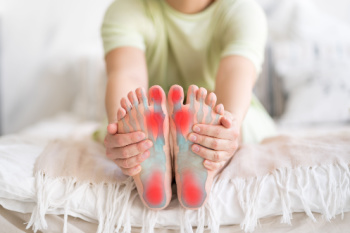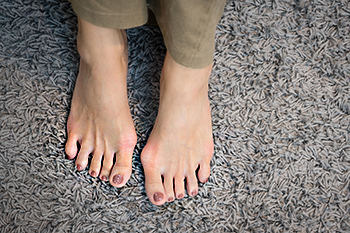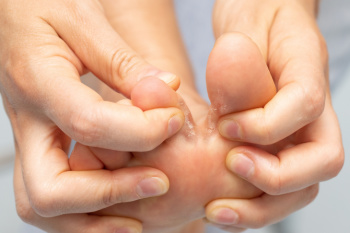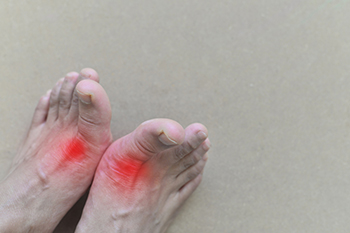
Drexel Hill (484) 521-0233
West Chester (610) 436-5883

Drexel Hill (484) 521-0233
West Chester (610) 436-5883

For those with rheumatoid arthritis, or RA, proper foot care is essential to manage pain and prevent mobility issues. RA often affects the joints in the feet, causing swelling, stiffness, and pain that can worsen without special attention. Consistent and gentle foot exercises help maintain joint flexibility while wearing supportive footwear minimizes stress on sensitive areas. Look for shoes with cushioned soles, wide toe boxes, and arch support to ease pressure on joints. Daily inspection of the feet is important for spotting redness, sores, or deformities early, as RA can make skin and nails more prone to damage. Applying moisturizer helps prevent dry skin and cracks. If you have RA and have pain or deformities like bunions that worsen, it is suggested that you schedule an appointment with a podiatrist who can recommend custom orthotics or special footwear adjustments, providing relief and improving mobility.
Because RA affects more than just your joints, including the joints in your feet and ankles, it is important to seek early diagnosis from your podiatrist if you feel like the pain in your feet might be caused by RA. For more information, contact the podiatrists of Dr. Siegerman & Associates. Our doctors will assist you with all of your podiatric concerns.
What Is Rheumatoid Arthritis?
Rheumatoid Arthritis (RA) is an autoimmune disorder in which the body’s own immune system attacks the membranes surrounding the joints. Inflammation of the lining and eventually the destruction of the joint’s cartilage and bone occur, causing severe pain and immobility.
Rheumatoid Arthritis of the Feet
Although RA usually attacks multiple bones and joints throughout the entire body, almost 90 percent of cases result in pain in the foot or ankle area.
Symptoms
Diagnosis
Quick diagnosis of RA in the feet is important so that the podiatrist can treat the area effectively. Your doctor will ask you about your medical history, occupation, and lifestyle to determine the origin of the condition. Rheumatoid Factor tests help to determine if someone is affected by the disease.
If you have any questions please feel free to contact one of our offices located in Drexel Hill and West Chester, PA . We offer the newest diagnostic and treatment technologies for all your foot and ankle needs.

Bunions are bony bumps that form on the joint at the base of the big toe, often causing pain, swelling, and stiffness. While bunions are primarily structural issues, targeted exercises can help manage discomfort, improve flexibility, and slow progression. Toe stretches, big-toe circles, and towel scrunches are effective for maintaining joint mobility. Resistance exercises with a band around the big toe can also strengthen the surrounding muscles, helping stabilize the foot. However, if pain from a bunion persists or limits your daily activities, it is suggested that you visit a podiatrist for a comprehensive treatment plan, which may include custom orthotics, footwear advice, and in severe cases, surgical options.
If you are suffering from bunion pain, contact the podiatrists of Dr. Siegerman & Associates. Our doctors can provide the care you need to keep you pain-free and on your feet.
What Is a Bunion?
Bunions are painful bony bumps that usually develop on the inside of the foot at the joint of the big toe. As the deformity increases over time, it may become painful to walk and wear shoes. Women are more likely to exacerbate existing bunions since they often wear tight, narrow shoes that shift their toes together. Bunion pain can be relieved by wearing wider shoes with enough room for the toes.
Causes
Symptoms
In order to diagnose your bunion, your podiatrist may ask about your medical history, symptoms, and general health. Your doctor might also order an x-ray to take a closer look at your feet. Nonsurgical treatment options include orthotics, padding, icing, changes in footwear, and medication. If nonsurgical treatments don’t alleviate your bunion pain, surgery may be necessary.
If you have any questions, please feel free to contact one of our offices located in Drexel Hill and West Chester, PA . We offer the newest diagnostic and treatment technologies for all your foot care needs.

Athlete's foot, a common fungal infection, primarily affects the skin between the toes and on the soles of the feet. It thrives in warm and moist environments, making communal areas like pools and locker rooms prime breeding grounds. The main causes include direct contact with the fungus, damp socks, and poor foot hygiene. Symptoms typically include itching, burning, and peeling skin, in additon to redness and cracking, which can lead to more severe complications if untreated. Individuals may also experience blisters and a persistent odor. A podiatrist can effectively diagnose and treat athlete's foot. They may prescribe antifungal medications, recommend proper foot care routines, and provide advice on footwear to prevent future infections. In some cases, they might suggest lifestyle changes to minimize exposure to the fungus. If you are experiencing symptoms of athlete's foot, it is suggested that you schedule an appointment with a podiatrist for tailored advice and treatment.
Athlete’s Foot
Athlete’s foot is often an uncomfortable condition to experience. Thankfully, podiatrists specialize in treating athlete’s foot and offer the best treatment options. If you have any questions about athlete’s foot, consult with the podiatrists from Dr. Siegerman & Associates. Our doctors will assess your condition and provide you with quality treatment.
What Is Athlete’s Foot?
Tinea pedis, more commonly known as athlete’s foot, is a non-serious and common fungal infection of the foot. Athlete’s foot is contagious and can be contracted by touching someone who has it or infected surfaces. The most common places contaminated by it are public showers, locker rooms, and swimming pools. Once contracted, it grows on feet that are left inside moist, dark, and warm shoes and socks.
Prevention
The most effective ways to prevent athlete’s foot include:
Symptoms
Athlete’s foot initially occurs as a rash between the toes. However, if left undiagnosed, it can spread to the sides and bottom of the feet, toenails, and if touched by hand, the hands themselves. Symptoms include:
Diagnosis and Treatment
Diagnosis is quick and easy. Skin samples will be taken and either viewed under a microscope or sent to a lab for testing. Sometimes, a podiatrist can diagnose it based on simply looking at it. Once confirmed, treatment options include oral and topical antifungal medications.
If you have any questions, please feel free to contact one of our offices located in Drexel Hill and West Chester, PA . We offer the newest diagnostic and treatment technologies for all your foot care needs.

Gout is a form of arthritis resulting in sudden, severe pain, redness, and swelling that often affects the big toe. It occurs when uric acid builds up in the bloodstream, forming crystals in the joints. Common causes include a diet high in purines, which are found in red meat, seafood, and alcohol. Obesity, and certain medical conditions, like hypertension, may also be factors. Symptoms of gout typically appear suddenly, often at night, and can last for days. While the intense pain can subside, recurrent attacks may occur, leading to chronic discomfort. Treatment options include medications to manage pain and inflammation, lifestyle changes such as dietary adjustments, and maintaining a healthy weight. A podiatrist can play a key role in managing gout by providing a personalized care plan, advising on footwear choices to reduce joint stress, and recommending targeted exercises to improve mobility. If you are experiencing symptoms of gout, it is suggested that you schedule an appointment with a podiatrist for expert guidance and support.
Gout is a painful condition that can be treated. If you are seeking treatment, contact the podiatrists from Dr. Siegerman & Associates. Our doctors will treat your foot and ankle needs.
What Is Gout?
Gout is a form of arthritis that is characterized by sudden, severe attacks of pain, redness, and tenderness in the joints. The condition usually affects the joint at the base of the big toe. A gout attack can occur at any random time, such as the middle of the night while you are asleep.
Symptoms
Risk Factors
Prior to visiting your podiatrist to receive treatment for gout, there are a few things you should do beforehand. If you have gout you should write down your symptoms--including when they started and how often you experience them, important medical information you may have, and any questions you may have. Writing down these three things will help your podiatrist in assessing your specific situation so that he or she may provide the best route of treatment for you.
If you have any questions, please feel free to contact one of our offices located in Drexel Hill and West Chester, PA . We offer the newest diagnostic and treatment technologies for all your foot care needs.
Request a free copy of
Laser Away Foot Pain!
today.
